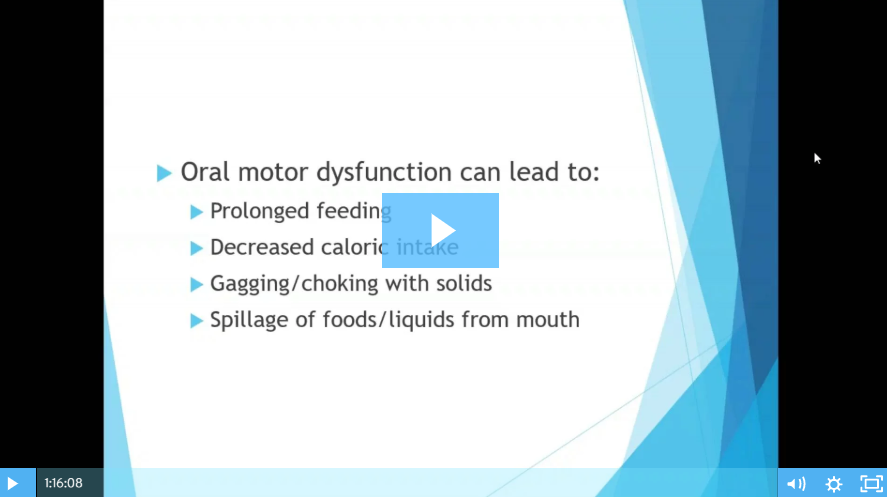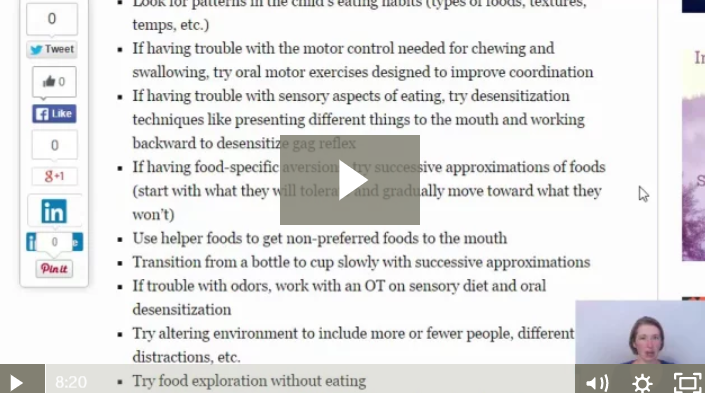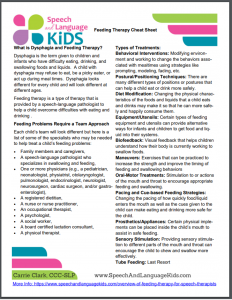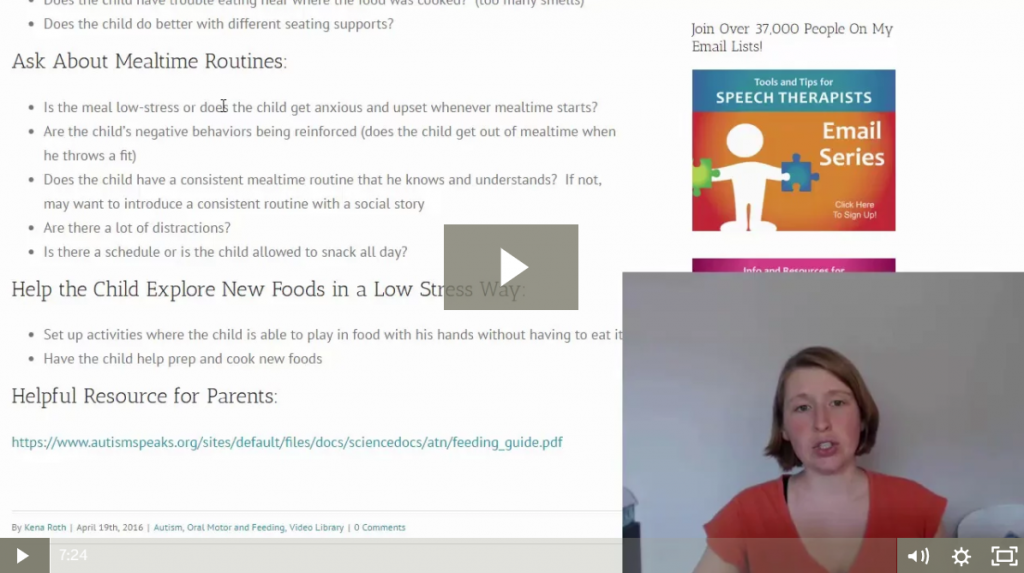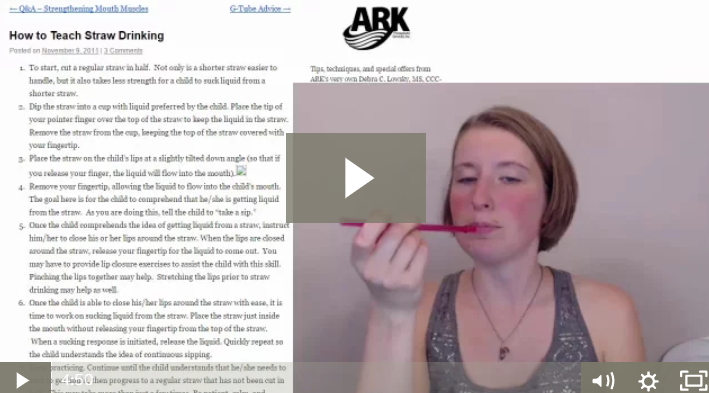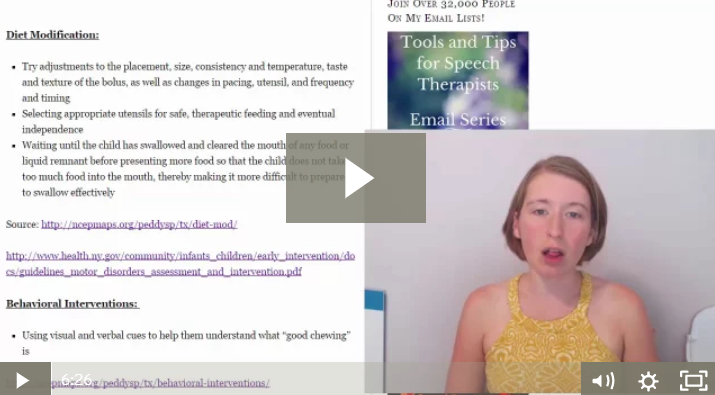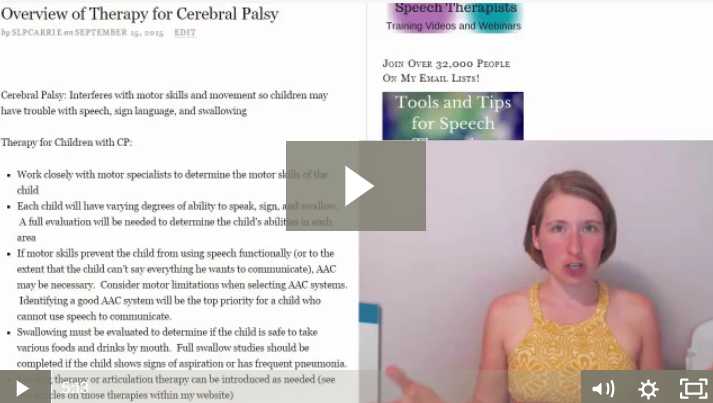Condition: Feeding and Swallowing Concerns (Dysphagia)
Jump To:
Norms by Age Evaluation Suggested Goals Therapy
Definition:
Feeding disorders are problems with a range of eating activities that may or may not include problems with swallowing. Feeding disorders can be characterized by one or more of the following behaviors:
- Avoiding or restricting one’s food intake (avoidance/restrictive food intake disorder [ARFID]; American Psychiatric Association, 2016)
- Refusing age-appropriate or developmentally appropriate foods or liquids
- Accepting a restricted variety or quantity of foods or liquids
- Displaying disruptive or inappropriate mealtime behaviors for developmental level
- Failing to master self-feeding skills expected for developmental levels
- Failing to use developmentally appropriate feeding devices and utensils
- Experiencing less than optimal growth (Arvedson, 2008)
Swallowing disorders (dysphagia) can occur in one or more of the four phases of swallowing and can result in aspiration—the passage of food, liquid, or saliva into the trachea—and retrograde flow of food into the nasal cavity.
Source: https://www.asha.org/Practice-Portal/Clinical-Topics/Pediatric-Dysphagia/
Developmental Norms:
Check out the following excerpt from an interview with Diane Bahr on the Ages and Stages website. This information comes from her book about infant mouth development and is an amazing resource if you’re looking for more information and training.
Source: http://www.agesandstages.net/qadetail.php?id=40
Birth to 3-month period (pp. 46-48) a baby:
-Roots to find the breast and/or bottle (if the parents use paced bottle feeding, pp. 25-26)
-Is fed breast milk and/or formula
-Moves from reflexive suckling to long bursts of purposeful sucking (e.g., 20+ without a pause)
3 to 6-month period (pp. 47-51), a baby’s mouth continues to develop. The baby:
-Roots less
-Develops a three-dimensional suck (where the tip and sides of the tongue move upward giving the tongue a nice bowl shape, the lips are puckered, and the cheek and jaw muscles begin to do the work that the fat pads were previously doing). The fat pads in the cheeks usually go away during this period.
6 to 9-month period (pp. 202-205) babies:
-Open their mouths just enough for the spoon to enter
-Start using the upper lip to clear food from the spoon
-Can pick up pieces of food with the fist and pass food from one hand to the other
-Begin moving the jaw just enough to match the shape and size of the food in the mouth
-Use their lips and cheeks to hold food within the mouth
-Begin to move their tongues toward food placed on the gums
-Begin getting a couple more teeth with appropriate chewing and biting experiences
Therefore the baby is ready for a number of foods between 6 and 8-months (pp. 182-183):
-Milled, blended, or well-mashed fruits and vegetables that are well-cooked with soft lumps and given from a spoon
-Wheat-free baby cereal, wheat-free soft cookies and crackers
-Cooked sticky rice
-Sips of water and very diluted fruit and vegetable juices in an open cup (held by an adult) or a straw cup in addition to breast milk and formula
Between 7 and 10-months, you can introduce (p. 183):
-Chopped cooked fruits and vegetables, including canned fruits but not citrus
-Soft cheese
-Mashed cooked beans and tofu
-Wheat and corn products
During the 9 to 12-month period (pp. 206-207), babies:
-Begin to hold and bang the spoon
-Begin to pick up small pieces of food with the thumb and fingers
-Can break off cookie and cracker pieces with their hands when cookies or crackers are held by their jaws
-Move the jaw in an increasingly mature manner to match the shape and size of the food
-Move food from the center of the tongue to the gums for chewing
-Can drink from a straw-cup or from an open cup (held by an adult) with consecutive swallows (i.e., swallow after swallow)
During the 9 to 12-month period (pp. 183-184) you can introduce:
–Soft, cut-up cooked and raw foods while slowly introducing citrus
-Cooked fruit and vegetable strips
–Soft, chopped meats (e.g., stewed meats)
-Casseroles with noodles, pasta, and rice
-Bread, toast, crackers, and dry cereal
-Eggs (yolks at 9 months, whites at 12 months)
-Soft cheese strips, cottage cheese, and baby yogurt
Feeding development continues through 24 months. By 24 months a child’s feeding skills are just about the same as yours and mine. The 12 to 24-month period is a time for the refinement of the feeding skills begun in the first year. You can find these and others specifics about the critical learning period for feeding (i.e., birth to 24-months) in my book (Chapters 2 and 6).
Get the Book Here: http://www.agesandstages.net/parentbook.php
Or, take one of her courses: http://www.agesandstages.net/courses.php
Evaluation:
If you suspect a child has a feeding or swallowing problem, a full evaluation should be conducted.
Here are the assessment recommendations according to the American Speech-Language Hearing Association’s website:
Consistent with the World Health Organization’s (WHO) International Classification of Functioning, Disability and Health (ICF) framework (ASHA, 2016a; WHO, 2001), comprehensive assessment is conducted to identify and describe
- impairments in body structure and function, including the swallowing phases that are affected;
- co-morbid deficits or conditions, such as developmental disabilities or syndromes;
- limitations in activity and participation, including the impact on overall health (including nutrition and hydration) and the child’s ability to participate in routine activities (e.g., family meals, meals at daycare and school, birthday celebrations with friends);
- contextual (environmental and personal) factors that serve as barriers to or facilitators to successful nutritional intake (e.g., child’s food preferences; family support in implementing strategies for safe eating and drinking); and
- the impact of feeding and swallowing impairments on quality of life of the child and family.
(Source: https://www.asha.org/PRPSpecificTopic.aspx?folderid=8589934965§ion=Assessment)
Here are some additional resources that will help you with various aspects of evaluating this condition:
Evaluation of Feeding & Swallowing Disorders – Webinar Recording
A one-hour webinar recording that shows you how to conduct a comprehensive evaluation of feeding and swallowing skills in children.
Suggested Goals:
The results of the assessment process should help guide what you will target in therapy for a child with feeding and/or swallowing disorders. Here are some goals that you may be addressing with this population. You can click on one of the goals below to learn more. Or, scroll down to the therapy section for more in-depth resources and support for treating this condition.
- Goal Suggestions Coming Soon!
Therapy:
Here are some more resources and information that may help you when it comes to treating this condition.
Quick Tips for Feeding Therapy Success
Watch this 8-minute video with quick tips on treating feeding disorders in therapy.
This quick PDF overview explains what dysphagia and feeding therapy is, how the team approach to feeding therapy works, and what types of treatments are available to use with children with feeding problems.
Feeding Therapy for Children with Autism
A 7-minute video that shows an overview of addressing feeding problems in children with autism. This overview is helpful for children with other diagnoses as well.
Introducing New Textures in Feeding Therapy
Learn how to gradually introduce a child to a new texture of food that he/she is currently refusing or not eating.
This quick video will show you one strategy for helping a child learn to drink from a straw.
This short video will walk you through some strategies to try for improving chewing skills.
Overview of Therapy for Cerebral Palsy
This video will give you a brief overview of treating children with Cerebral Palsy, including how to address swallowing and feeding concerns.
Didn’t Find What You’re Looking For?
We’re constantly working on adding new features and topics to this membership site. If you don’t find what you’re looking for by using the search bar at the top of the page, please use the button below to request new features or topics to be added!

